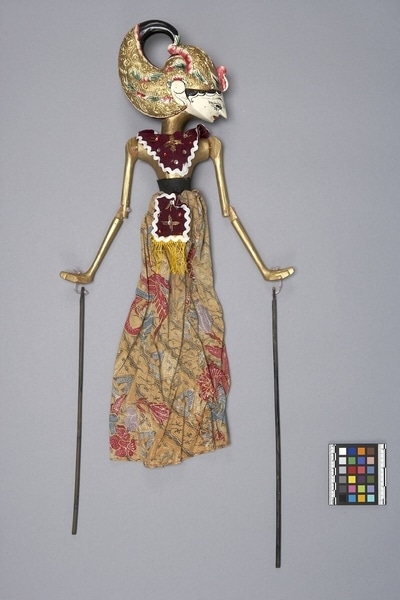Rod Puppet Item Number: Ib414 a-c from the MOA: University of British Columbia


Description
Three-dimensional male humanoid puppet (Arjuna, Pandhawa Prince character): large head (part b) fits into body with skirt (part a), and a control rod (part c) with a long shaft that passes through the body and fits into the neck of the figure's head. The body has jointed arms, each with a long controlling rod attached. White face with delicate features positioned downwards. Straight pointed nose, long but slight eyes outlined in black, closed red lips. Facial details, hair, eyebrows in black. Ornate upswept curl (gelung supit urang) headdress in black, gold, red, and green. Small bird representation at forehead (a form of Garuda Mungkur). Detailed sumping, lungsen. Gold neck and torso; hands held flat and bent back at wrist. No arm ornaments. Purple chest covering and apron with white wavy trim, with sequins and beads and twisted wire decoration. Apron has wide black waistband and long yellow fringe at bottom. Long batik skirt, beige with red, blue, and lavender.
History Of Use
Javanese puppetry as an art form probably developed by the 11th century. Wayang golek puppets of western Java appeared during the 16th century. Originally the plays depicted Javanese mythology, but after the Indian conquest of Java the Hindu epics, Ramayana and Mahabharata, were incorporated into the cycles, which comprise about 200 plays. A dalang (puppet master) performs the plays to celebrate important occasions, usually in three acts, with vocal and instrumental accompaniment. Typically they serve a moral and religious purpose, and more recently, one of political commentary. Arjuna is a prince (raden), third of the Pandawa brothers, and one of the most refined characters in the wayang. He is possibly the most important protagonist in the Mahabharata cycle of plays, which involves the usurpation of the Pandawa throne by the Kurawa brothers, and their eventual defeat. Although Arjuna is highly refined, he has at least one characteristic which is associated with evil: he is an impetuous lover, the 'Don Juan' of the wayang. In this way, the tempering of all characters (except ogres) with opposite characteristics, the battle between good and evil, is shown to be somewhat ambiguous.
Cultural Context
Theatrical performance.
Iconographic Meaning
Arjuna, a Pandhawa prince. Each puppet is characterized by its wanda, a Javanese word which describes the specific mixture of elements of size, form, colour, ornamentation and carving. Facial colour, position, and elegance of figure are highly refined and suggest virtue. Gold skin, position of hands, batik, and headdress indicate high nobility. Garuda also denotes nobility.
Item History
- Made in Java, Indonesia
- Owned by Donald Bone before January 4, 1980
- Received from Donald Bone (Seller) and Museum of Anthropology Donations Fund (Funding source) on January 4, 1980
What
- Name
- Rod Puppet
- Identification Number
- Ib414 a-c
- Type of Item
- puppet
- Material
- wood, cotton fibre, fibre and paint
- Manufacturing Technique
- carved, painted, tied, woven and sewn
- Part A
- height 57.5 cm, width 16.0 cm, depth 6.3 cm
- Part B
- height 17.0 cm, width 8.0 cm, depth 16.0 cm
- Part C
- height 38.0 cm, width 2.1 cm, depth 1.0 cm
Who
- Culture
- Sundanese
- Previous Owner
- Donald Bone
- Received from
- Donald Bone (Seller) and Museum of Anthropology Donations Fund (Funding source)
Where
- Holding Institution
- MOA: University of British Columbia
- Made in
- Java, Indonesia
When
- Ownership Date
- before January 4, 1980
- Acquisition Date
- on January 4, 1980
Other
- Condition
- fair
- Accession Number
- 0586/0034 a-c